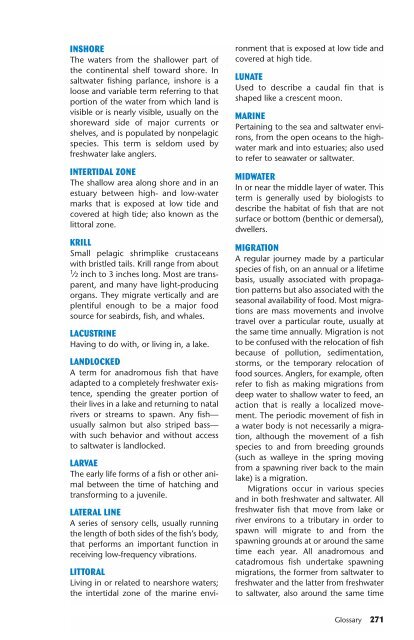Ken Schultz's Field Guide to Saltwater Fish - Macaw Pets store
Ken Schultz's Field Guide to Saltwater Fish - Macaw Pets store
Ken Schultz's Field Guide to Saltwater Fish - Macaw Pets store
You also want an ePaper? Increase the reach of your titles
YUMPU automatically turns print PDFs into web optimized ePapers that Google loves.
INSHORE<br />
The waters from the shallower part of<br />
the continental shelf <strong>to</strong>ward shore. In<br />
saltwater fishing parlance, inshore is a<br />
loose and variable term referring <strong>to</strong> that<br />
portion of the water from which land is<br />
visible or is nearly visible, usually on the<br />
shoreward side of major currents or<br />
shelves, and is populated by nonpelagic<br />
species. This term is seldom used by<br />
freshwater lake anglers.<br />
INTERTIDAL ZONE<br />
The shallow area along shore and in an<br />
estuary between high- and low-water<br />
marks that is exposed at low tide and<br />
covered at high tide; also known as the<br />
lit<strong>to</strong>ral zone.<br />
KRILL<br />
Small pelagic shrimplike crustaceans<br />
with bristled tails. Krill range from about<br />
1 ⁄2 inch <strong>to</strong> 3 inches long. Most are transparent,<br />
and many have light-producing<br />
organs. They migrate vertically and are<br />
plentiful enough <strong>to</strong> be a major food<br />
source for seabirds, fish, and whales.<br />
LACUSTRINE<br />
Having <strong>to</strong> do with, or living in, a lake.<br />
LANDLOCKED<br />
A term for anadromous fish that have<br />
adapted <strong>to</strong> a completely freshwater existence,<br />
spending the greater portion of<br />
their lives in a lake and returning <strong>to</strong> natal<br />
rivers or streams <strong>to</strong> spawn. Any fish—<br />
usually salmon but also striped bass—<br />
with such behavior and without access<br />
<strong>to</strong> saltwater is landlocked.<br />
LARVAE<br />
The early life forms of a fish or other animal<br />
between the time of hatching and<br />
transforming <strong>to</strong> a juvenile.<br />
LATERAL LINE<br />
A series of sensory cells, usually running<br />
the length of both sides of the fish’s body,<br />
that performs an important function in<br />
receiving low-frequency vibrations.<br />
LITTORAL<br />
Living in or related <strong>to</strong> nearshore waters;<br />
the intertidal zone of the marine envi-<br />
ronment that is exposed at low tide and<br />
covered at high tide.<br />
LUNATE<br />
Used <strong>to</strong> describe a caudal fin that is<br />
shaped like a crescent moon.<br />
MARINE<br />
Pertaining <strong>to</strong> the sea and saltwater environs,<br />
from the open oceans <strong>to</strong> the highwater<br />
mark and in<strong>to</strong> estuaries; also used<br />
<strong>to</strong> refer <strong>to</strong> seawater or saltwater.<br />
MIDWATER<br />
In or near the middle layer of water. This<br />
term is generally used by biologists <strong>to</strong><br />
describe the habitat of fish that are not<br />
surface or bot<strong>to</strong>m (benthic or demersal),<br />
dwellers.<br />
MIGRATION<br />
A regular journey made by a particular<br />
species of fish, on an annual or a lifetime<br />
basis, usually associated with propagation<br />
patterns but also associated with the<br />
seasonal availability of food. Most migrations<br />
are mass movements and involve<br />
travel over a particular route, usually at<br />
the same time annually. Migration is not<br />
<strong>to</strong> be confused with the relocation of fish<br />
because of pollution, sedimentation,<br />
s<strong>to</strong>rms, or the temporary relocation of<br />
food sources. Anglers, for example, often<br />
refer <strong>to</strong> fish as making migrations from<br />
deep water <strong>to</strong> shallow water <strong>to</strong> feed, an<br />
action that is really a localized movement.<br />
The periodic movement of fish in<br />
a water body is not necessarily a migration,<br />
although the movement of a fish<br />
species <strong>to</strong> and from breeding grounds<br />
(such as walleye in the spring moving<br />
from a spawning river back <strong>to</strong> the main<br />
lake) is a migration.<br />
Migrations occur in various species<br />
and in both freshwater and saltwater. All<br />
freshwater fish that move from lake or<br />
river environs <strong>to</strong> a tributary in order <strong>to</strong><br />
spawn will migrate <strong>to</strong> and from the<br />
spawning grounds at or around the same<br />
time each year. All anadromous and<br />
catadromous fish undertake spawning<br />
migrations, the former from saltwater <strong>to</strong><br />
freshwater and the latter from freshwater<br />
<strong>to</strong> saltwater, also around the same time<br />
Glossary 271


